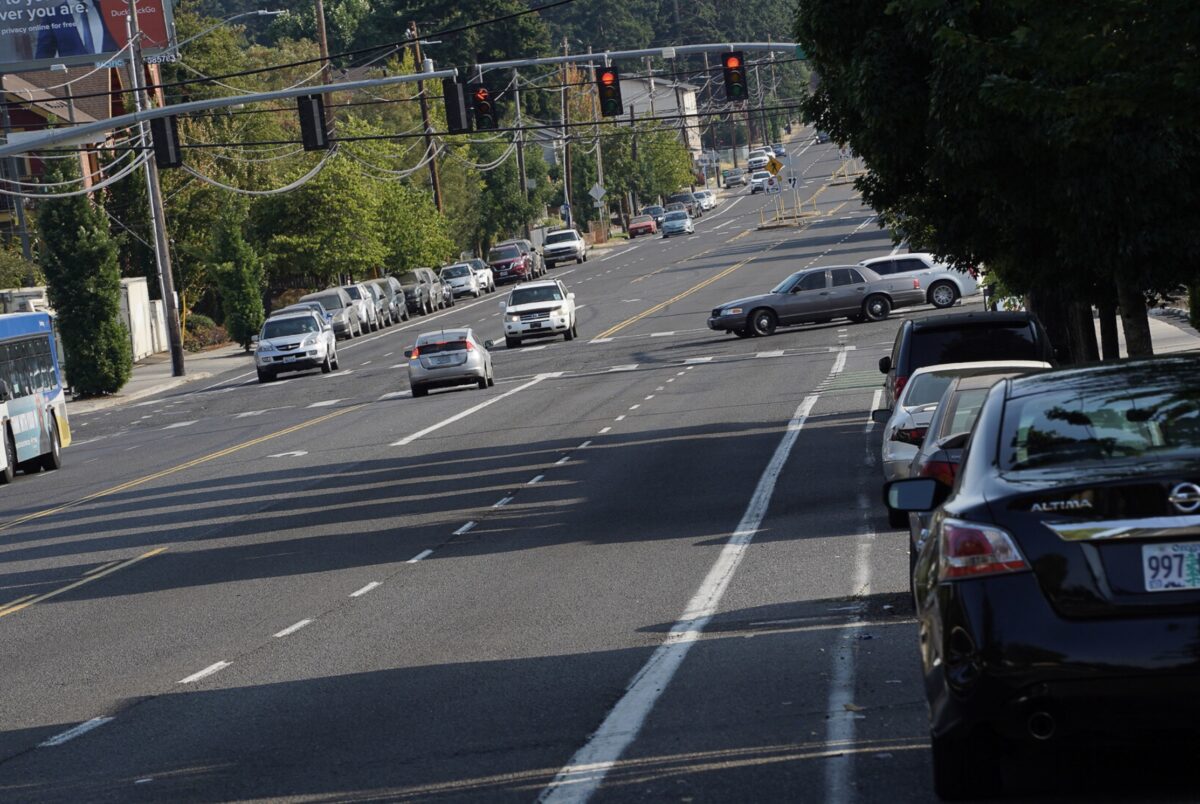
Right now, 122nd Ave is a scary street for many people to use. It has nine lanes: two general lanes in each direction, a center turn lane, two lanes for parking and two bike lanes. The cycling space is unprotected and between parked cars and other travel lanes buffered only by thin lines of paint. The wide cross-section makes it difficult to cross safely and encourages bad decisions.
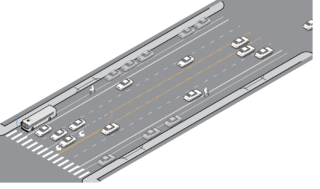
These are issues PBOT seeks to improve with its 122nd Ave Plan, and they want your feedback on what they should prioritize in the redesign of a key section.
While changes will ultimately be made to all of 122nd Ave (which stretches 6.4 miles from SE Foster Road up to NE Marine Drive) as part of this plan, PBOT is currently considering how best to use initial funding from the Fixing Our Streets program to redesign just the 1.4 mile segment from Foster to SE Powell Blvd.
Earlier this year, PBOT released community feedback they received about the 122nd Plan, noting some people were torn between maintaining car traffic space and adding more protection for people walking and biking. Another high priority item seemed to be adding green space to the street, as it lacks canopy coverage that’s not only visually appealing, but also helps cool streets when large expanses of pavement drive up temperatures on hot days.
Based on that feedback, PBOT has created three options with renderings for the redesign between Foster and Powell. All three options increase protection for people riding in the bike lanes, add a center median and trees to varying degrees of priority. What’s not up for debate is that the space currently devoted to two lanes used for driving will be reallocated to more important uses — a move PBOT says won’t cause increased congestion.
Advertisement
Here’s the lowdown on the options:
The first option focuses on buffered bike lanes, which beefs up the paint buffer between the bike lanes and car parking/car traffic. This option maintains most of the current parking space, and of all the choices, it provides the least space for adding trees

The second option is to create parking protected bike lanes, which would move car parking space to be directly adjacent to car traffic space so the bike lanes are adjacent to the sidewalk. In this case, parking space would get about a 50% reduction and there would be more space for trees along some corners.
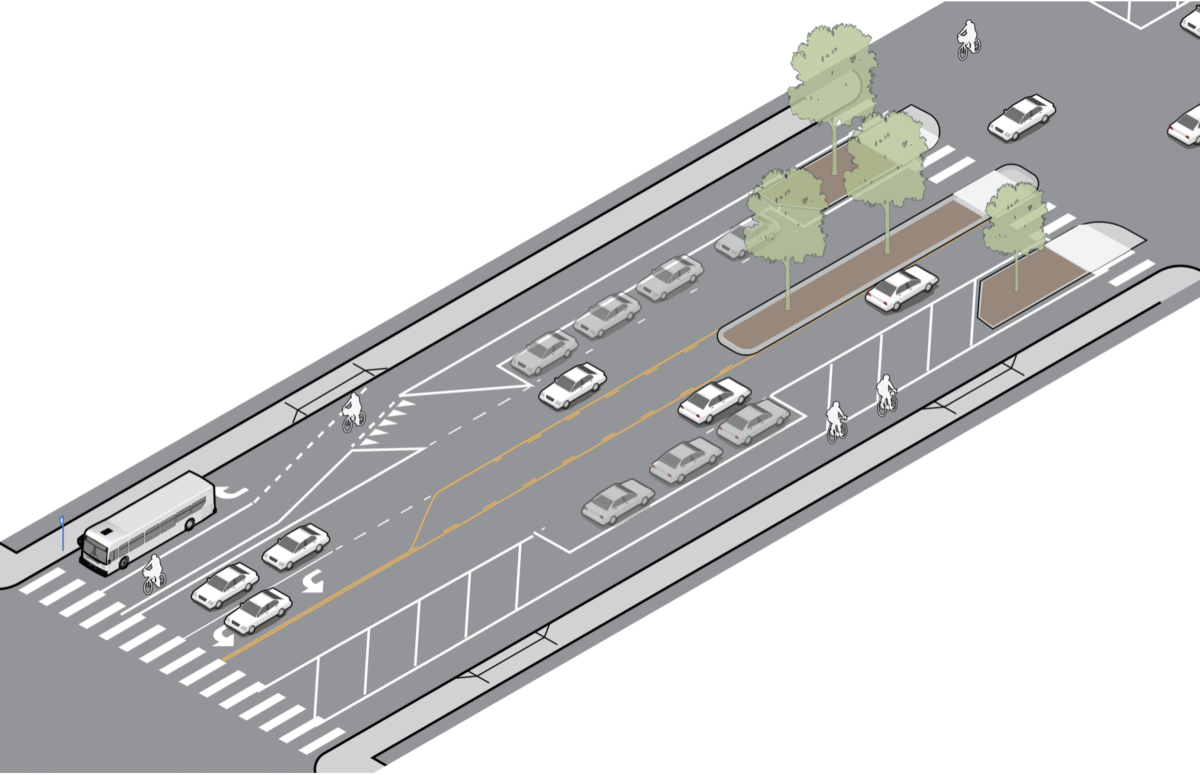
The third option is the most dramatic redesign. This option provides ample space for trees and landscaping in very wide center medians, cutting back on the buffer between bike lanes and car traffic but significantly shortening the amount of time people crossing the street have to be in the line of car traffic. People driving wouldn’t be able to access driveways directly due to the center median and would need to make U-turns. This design would require additional funding to implement.
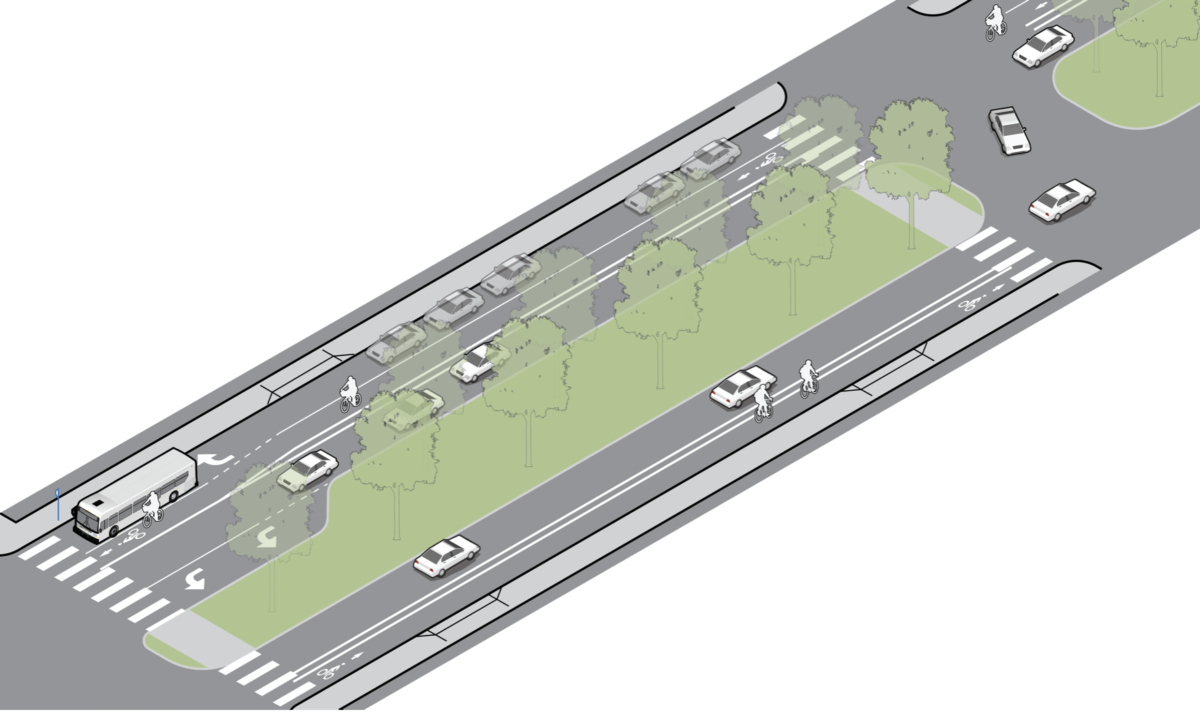
PBOT plans to begin construction on this section of 122nd in 2024. You can find out more about the redesign at the project website and give feedback through the survey, which will be open through June 16th.

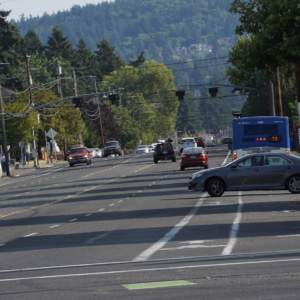
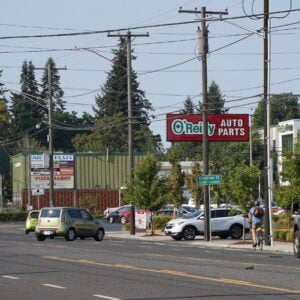
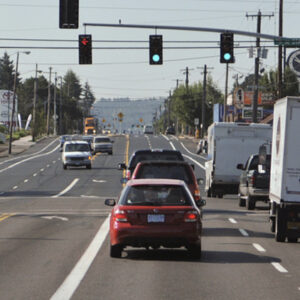

Thanks for reading.
BikePortland has served this community with independent community journalism since 2005. We rely on subscriptions from readers like you to survive. Your financial support is vital in keeping this valuable resource alive and well.
Please subscribe today to strengthen and expand our work.
Are any of these concepts going to get buy off from the Water Bureau / Bureau of Environmental Services? The concept imagery for Outer Division always showed trees in the median, but the final designs only included trees for one block at 84th. Like Division, 122nd also has a sewer line going the middle of the street.
I wonder if the trees would be able to fit between the utility lines/pipes and the proposed roadway? Could the center be kept grassy and therefore access to the pipes open (in other words, what is the minimum planting distance between trees and sewer lines)? I’m sure that BES would be concerned about roots finding their way in.. but I would rather pay for improved pipe design/more regular maintenance if it meant more tree canopy.
The offset for water pipes is 10′ from the outside of the pipe diameter to the outside of the trunk at maturity. Most other utilities will accept a 5′ offset.
I love the large green space, but would not be green in the summer without irrigation. The plants would need to be kept low to maintain sightlines (limited shrubs), and utilitiy conflicts would limit tree planting locations. That said, this could be an amazing linear garden planted with climate-adapted species. It would be cool to include a center path, and benches. The question of maintenance arises: PBOT has explicitly cut all landscape maintenance from its budget. They may restore that, but that restoration should be considered temporary (see the landscape at NE 102nd/Weidler). If PBOT is prepared to convert this much space to greenspace, I think it would much more valuable and useful to put it all on one side of the road, or split i t and put half on each side of the road. This would create enormous urban design opportunities that might spur a lot of creative redevelopment and make a unique and vibrant pedestrian green space connected to businesses. Having the greenspace adjacent to businesses would open the potential for a business to add an improvement: plaza for restaurant seating, garden, space for sidewalk sale or temp market, etc.
Exactly–putting the green space alongside one or both sides of the road makes way more sense than isolating it in the middle, between vehicle lanes, for all the reasons you said.
Greenspace has high buffer value buffering sidewalks and bike lanes from vehicle traffic lanes. There’s no need to buffer traffic lanes from each other, so putting it between vehicle lanes squanders it.
Putting all the green space in the middle, so people can look at it but not access it, reminds me of isolating downtown’s elk statue in the midst of traffic lanes.
I know at one point a few years ago the city revised their standards and it meant a couple thousand properties now couldn’t plant street trees in their strip between the sidewalk and street due to buried water mains in the street. There are a lot of stipulations on where street trees can’t go, see page 4:
https://www.portland.gov/sites/default/files/2020/street-tree-planting-standards-2-26-20.pdf
With that said, a project like this needs special permission or something so that we can get MORE TREES installed in these areas of vast heat islands.
I’m a big fan of streets split with one-way traffic on each side of a large parklike median/verge. 122 would be perfect for this.
Outer Division has a major Bull Run aqueduct down the center of the roadway, as does the north side of outer Powell and along outer Caruthers (a local street). Division and Powell also have much smaller storm sewers, water mains, and sewerage lines near the gutter lines, as does 122nd and most other major arterial roadways (and many minor ones too.) Unlike Division, PBOT engineers and planners are not particularly worried about adding treelined medians to 122nd other than the added cost of moving earth, sewer lines, and other utilities when the curbs are moved.
There’s a major aqueduct running down Division, but it’s the sewer line that is typically at the center of the ROW. That sewer line jogs between 84th and 85th, which is why they were able to install trees at that location only. 122nd also has a sewer line going down the center of the ROW, so I don’t see why we should expect a different outcome.
how about this cross section: move the curb intothe road 2′ to widen the planting strip to 5′-6′- plant that with low-growing, drought-tolerant shrubs and perennials. Put a nice 6′-7′ parking-protected bike lane adjacent to the new curb BUT include 6’widex8′ long tree planters in the parking lane on 50′ centers; so cars park between them. This offers premanent protection for the bike lane, the bike lane gets an allee of trees, and the road gets much better shading than typical street trees or median trees.
I like the option with trees best. Given Portland’s current anti-tree planning, we need all the trees we can get, especially if it breaks up large stretches of pavement. Bonus if the medians can be designed as swales to collect stormwater and deter camping.
PBOT is going to get a lot of push back on option three. People complaining about the changes to Division have been very loud about it. They like the safer streets for schools but not if it means they can’t make a left where they’re used to. They also want less cut through traffic but don’t want diversion. No one has any ideas how to do that but the current design is unacceptable to them. The end result of that campaign if it’s successful is going to be the continuation of unsafe streets in East Portland.
Seriously every complainer thread on Division is basically “THIS IS THE WORST BECAUSE I CAN’T SPEED AND DRIVE ALL OVER THE ROAD AND WHEREVER I PLEASE ANYMORE, BLAAAAAHHHRRRGGGHHHH…”
Division is legit terrible. I’m struggling to find any bright side to it. The city definitely gets some weird satisfaction by having bikes go over speed bumps and ped islands. Driving it is wild as well and I sadly can’t help but think this is the way to deal with drunk drivers… They legit get paid too much to not be able to find ways to prevent cyclists from these unnecessary features. Shoot, we already have to deal with needles, glass, parked cars, and rocks in the outer east side bike lanes.
I hope this document helps somehow. A MURP Workshop project about the 122nd Ave. Corridor from 2008 with land use and transportation recommendations.
https://pdxscholar.library.pdx.edu/cgi/viewcontent.cgi?article=1023&context=usp_murp
I agree. It’s time to reconfigure our streets to prioritize walking because a truly pedestrian-friendly city will also encourage cycling (even if the dedicated cycling infrastructure is not “world class”).
If they go with the median they should copy what Chicago did on South Drexel (pedestrian path and water fountains within the planted median), and not what they did on South Garfield (just grass).
I’m surprised the roundabout at Harold didn’t come up for discussion yet…
I am thrilled this is finally happening! Oh, so necessary. I’m pretty sure the lanes are currently narrower than my bike’s handlebars.
I think the parking protected lanes are the best option. It isn’t just paint, and will do the best job of getting drivers to slow down. It would be lovely to not hear people drag racing down 122nd at 1am!
The buffered lane option is what we have on Holgate, and while it is decent, even if it is just paint, I don’t like playing dodge ’em with the bus. Plus, one of my pet peeves is drivers using the bike lane to turn right, which feels like the norm out here.
As for the median option, no way. Drivers will just park in the bike lane. And no, they won’t get towed for it. (Plus, let’s face it, those medians would be the perfect place to camp.)
I agree. The furthest people on bikes are from cars the better. With protected bike lanes you are 11 feet from cars, with a buffer it is just 3. The city is going to attract a lot more interested but concerned with a protected bike lane.
I’d generally agree and favor separated lanes. The condition of the nice new separated lanes along Powell east of 122nd though doesn’t give me much to get excited about. I’d rather have painted lanes. They aren’t as cluttered with glass and debris, and you can at least get out into the lane to steer clear if needed. I’d like to live in a world where I thought separated lanes could be built and maintained in a rideable condition, but…(see numerous BP stories regarding general pessimism and dissatisfaction about the city)
We have narrow sweepers that would fit in a buffered bike lane but the city only runs sweepers at night (which I guess is why I’ve never seen a bike lane being swept). I’d gladly accept occasional sweeper encounters if it meant doubling the lane miles swept every day.
What I told PBOT is I’d like to see design three, but with the planters in the parking lane extended all the way along the parking lane. It would more nicely separate peds and bikes from the transit lane
I’m confused why this is even a debate. We have decades of data from other countries about road design. We know what is safe and what works based off of this convergence of evidence. It’s depressing to see PBOT decide road design in this manner. If we want to make cycling a viable option, a physically protected network of bike lanes is how we do it. Public input should be centered around HOW the street looks given physically protected bike lanes in the design. This can include where bus stations should go, or what kind of trees people prefer… NOT what basic design the road should have.
This always sorta blows my mind too. Do what others have done, what data shows works, etc., make our streets safe for cyclists and pedestrians. Doesn’t seem like it should be so hard! I’m not the pro here, they are, so behave like it and don’t ask me what road design is “best”.
That’s always my thought with this kind of thing. No parking-protected lanes or physical separation, and the right turn still cuts into the bike lane. We know, at this point, what to do and not do; doing anything but the right thing feels like an indication of priorities. PBOT continues to disappoint.
Why should your view of what is “right” supersede everyone else’s view? PBOT has to balance a variety of factors, and the way you weight them may be different from the way others do.
This blog is full of people with strong opinions about road design, who have moral certainty that their views are simply better than everyone else’s.
If it were up to me, I would give the views of locals much heavier weight than those of infrequent users of the street. That means my opinion (and maybe yours) should count very little.
I don’t know if you know this, but locals can be and very often are wrong, or have priorities that don’t actual rationally serve what they claim their interests are. How you think this is a legitimate rebuttal when we know, without a doubt, that this is true, I’m not sure.
Who counts as “local” is subjective, and those people aren’t permanently affixed to where they are, in any case. (Maybe there would be more locals if those already local wouldn’t block development; maybe those new locals would agree to orient the street’s design to non-automotive use). Maybe those who are infrequent users of the streets would use the street more often if it were different. Maybe the locals would change their design priorities if the street were different. Maybe (and I can’t believe I have to clarify this point) safety should trump convenience, at least when the latter can very easily be compensated for in other ways (…don’t drive? again, can’t believe I’m having to that here).
Not to mention that even PBOT’s recommendations come with external ideas of what the “right” thing to do is (via NTSB, FHWA and MUTCD, USDOT), so total local control is already not actually there. Why muddy these already turbid waters further by putting people with major status quo bias in any real position of influence?
I think the notion that you can judge what people want or need better than they can is a bit arrogant. People are not helpless, and they are not stupid. They may not share your priorities, or your sense of what will best serve them, but why should that invalidate their opinion? And if you rarely use 122nd, why should your priorities matter at all?
….Have you met people?
I guess they should feel grateful that you are looking after their interests.
Maybe safety isn’t the only consideration. If it were, PBOT would just close the street.
This is the arguably the goal of BikePortland
False dichotomy: Stating safety isn’t the only consideration is clear to everyone here. A street gets designed for the movement of people (and typically for the movement of cars in the US). Hyperbole: PBOT has yet to prevent cars from physically accessing streets in any significant way (eg a diverter does not “close” a street).
When safety is a priority in design, all users benefit. For example, the data in NY re pedestrian, car and bike modes show a decrease in crashes after a PBL is installed.
https://www1.nyc.gov/html/dot/downloads/pdf/2014-11-bicycle-path-data-analysis.pdf
A person anecdote: I spent my weekends growing up riding a bike on the sidewalks of 122nd to get to the Springwater. If there were a safe alternative, I could have been able to ride to school, the store, friends houses, or work. That’s the difference. Designing 122nd for kids and old people can give everyone that option of independence. I stopped riding a bike in my teens because of 122nd. A physically separated design could have made my life growing up very different.
You seem to think that our opinion matters to them. I do recall the NE Halsey project that happened 2 years ago. They received the opinions and did what many asked against. Added to the historically bad outreach efforts and wallla!
Walking/rolling ranks higher on Portland’s transportation hierarchy (as delineated in the TST portion of its comprehensive plan). Given that option 3 is the most viable option for protecting people walking/rolling and creating a comfortable pedestrian network it’s how we should do it. People walking face more risk of severe injury or death in E Portland than in other areas of Portland so option 2 is also the most viable option from an equity and/or public health perspective.
For option 3, I would happily support protecting the “buffered” bike lane on one side by elevating it from the lower street level and placing a raised bike lane behind parking on the other side. The idea that a few or no parked cars is a safer configuration than a curb-protected bike lane is not supported by good evidence.
All three options are bad? Why are they even considering mixing zones? And surely there’s no good reason they can’t have a continous tree planter between the bike lane and car traffic.
Driveways. 122nd has lots of driveways. And they get used. Regularly.
So cars are going to be turning in and out of many frequently used driveways across the “protected” bike lanes in any scenario? I get that any design needs to work with the land use conditions on the ground, but perhaps some access management aka consolidating some driveways would be a vital component of any street redesign project.
Maybe PBOT could replace one of the travel lanes with a frontage road.
Multnomah County built 122nd to be a 3-lane arterial without on-street parking, with surrounding property owners being REQUIRED to put in off-street parking, hence all the frequent driveways. Just prior to the city annexing the area in the late 1980s the lanes were reduced by the county from 3 to 2 and parking and the painted bike lanes were added, as it was “best practice” to do so at the time (a bit like protected bike lanes are “best practice” today).
To put in a standard frontage road, you would need a right of way of about 130 feet; 122nd is only 90 feet on most of it, 100 feet at the widest.
On the other hand, if parking was once again eliminated completely, I could easily envision a cross section of a wide tree-lined 12′ sidewalk on each side, a 6-foot painted bike lane for the fast and fearless 2%, a 10-foot traffic lane, then a huge wide 32′ tree-lined median with shared bus and bike only lanes for the interested but concerned, traffic lane, painted bike lane, wide tree-lined sidewalk, to give 122nd a French boulevard treatment.
If you replaced the outer travel lane with a frontage road, and the frontage road were separated from the (now) single though lane with a dashed white line, the whole facility would be no wider than today. It would also be relatively cheap to build.
Option two is by far the best, option one and otpion three would still be unnecessary dangerous for cyclists. Option three also doesn’t really make sense – how are U turns going to improve safety? That sounds like a recipe for disaster. Option one, where is the advantage in having cars cross the bike lane to reach parking? Option two has acceptable medians AND still leaves the option open for protected bike lines in the future.
Would a design based on U-turns have longer light cycles?
Option 2 but make the median continuous with trees and add trees to separate the protected bike lane- now you have 3 rows of trees and two of them offer better shade to pedestrians than concentrating the space in the middle of the street where people don’t walk or access destinations.
More trees please!
To add to the discussion, yes, with the City’s (and many other Cities’) correct push to allow more housing in-fill it is this very type of space that will need to be redesigned to make up for the reduced opportunity for enhanced tree canopy and more likely tree removal on private property. For example, the City of Vancouver (USA) just announced it was at 14% tree canopy vs its goal of ~28%…its a “Tree City USA’!
The buffered option could be perfect with bike lanes at sidewalk level and protected intersections with no merge zone for turns, and either more parking or more trees instead of stupid striped paint buffer. personally would prefer trees, but I’m not against parking space if it quiets critics. anything but useless, ugly, painted asphalt buffer space!
I agree. Copenhagen-style cycle tracks are so underutilized here.
This will sound nuts, but what about a 2 way cycleway down the center of the street? Syracuse has something like that. I’m told it works well, and deals with a lot of the problems with driveways, drainage, etc.
https://maps.app.goo.gl/nQCMcEoxdsUpw7v67
Please keep the lanes straight, don’t do the lefty/righty shifty like on Division east of 92nd! People don’t pay attention and drift from their lanes! Just keep parking off busy roads and let everything be straight. Do concrete jersey protected bike lanes instead! Bike lanes protected by parked cars = T-bones of cars pulling out of driveways…. The sight angles get reduced!
Also, I would never ever park my car on such a busy street. I have seen so many hit/run into parked cars on busy roads. I always park in residential around the corner.
Yes. I hated what they did to NE Sandy on the last restriping. It plays like a highway, except with no consistent riding line for a person on a bike.